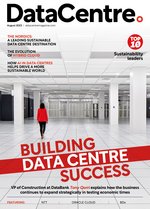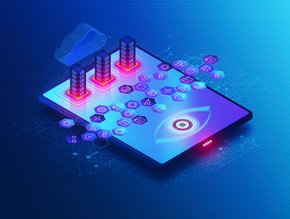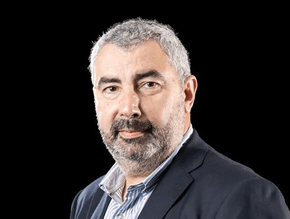How the data centre industry is addressing its DE&I problem

The topic of diversity, equity and inclusion (DE&I) is top of mind for pretty much all socially-aware companies at the moment, and those in the data centre industry are no different.
When it comes to the technology sector as a whole, the statistics paint a rather worrying picture. According to a recent report published by TechNation, just 26% of tech workers in the UK are women, compared to 50% of the overall labour market. Meanwhile, female minorities make up just 3-7% of IT employees.
While less research exists in relation to the data centre industry specifically, the workforce is widely accepted as being even more imbalanced. In 2021, more than three-quarters of data centre operators surveyed by the Uptime Institute said less than 10% of their staff members were women.
Improving DE&I from the inside
Marientina Laina was determined to take a leap of faith when she joined NTT Global Data Centers (GDC) to become Director of Sustainability, despite warnings from those around her. Part of her motivation was to do something about the lack of diversity from within.
“When I made the decision to join the tech sector, a lot of friends and colleagues asked ‘are you really sure? This is a really male-dominated industry’,” recalls Laina.
“At NTT GDC, increasing these kinds of figures [in favour of female representation] is a commitment and very meaningful priority for our DE&I programme. We are quite pleased that, since FY21, we have managed to increase female representation from 11% to 28% in executive leadership positions.
“Are we doing enough right now? No, but we are committed to doing better and doing more. We can always do better.”
Working as Technical Director at Mission Critical Management (MiCiM) and Managing Director at Operational Intelligence, Sophia Flucker has a cross-industry perspective on the DE&I situation.
Based in the UK and Ireland, MiCiM has more than half a century’s worth of experience in data centre construction projects, but is wary of the need to enhance its diversity efforts.
“A lot of this is borne out in the statistics,” says Flucker. “We know we [members of the data centre industry] are not as diverse as we should be so, certainly, we need to do more.
“I think the proportion of women in construction is even less. We’re still better than other companies – about 30% of our workforce is female – but it’s not enough and we’re still trying to improve our inclusivity so we can really benefit from having a much more rounded team.
“I’d also make the point that diversity and inclusion isn’t just about gender or one issue; there are so many different types of diversity and I think we really need to open up the conversation to think about how we’re dealing with different minorities.”
Industry must address skills shortage
Laina’s belief is that, to do better from a DE&I point of view, the industry needs to look at its existing practices from top to bottom. That means assessing everything from hiring procedures and the opportunities being afforded to different demographics, to career progression and whether enough is being done to help staff feel empowered in their jobs.
“If we do that in a way that is honest, informed by data and there is support from leadership,” she continues, “that will tell us quite a lot about what we can be doing in future in order to rectify all of that and make sure we attract and retain an increasingly diverse workforce.”
A huge issue impacting not just the data centre industry but the entire technology sector is the global skills shortage.
The aforementioned Uptime Institute estimated two years ago that 300,000 more workers would be needed to run the world’s data centres by 2025, taking the total to around 2.3 million.
Making better use of STEM education and apprenticeships has been highlighted as one of several potential solutions, while Flucker says the industry must also get better at self-promotion.
“The industry is growing so quickly that it becomes very hard to fill positions,” she adds. “A wider issue is that people are not so aware of the industry or jobs in technology and engineering in general.
“It actually starts very young. If children don’t think they want to be an engineer, you’ve already got a reduced talent pool.”
Mentorship benefits all parties
Mentorship and development evidently has a key part to play when it comes to attracting and retaining diverse talent within the data centre sphere.
Laina references a mentorship scheme launched some years ago by NTT GDC, which is boosted by sponsorship and targeted at helping women to excel in senior leadership positions. Sponsors help budding leaders on their journeys as they build up crucial skills, knowledge and capabilities.
“We have found the programme to be fantastic in our efforts to increase female representation,” Laina adds. “Often, we think of mentorship as an extra or a luxury, but we need to recognise why it is a priority and make space for it.”
NTT GDC’s Director of Sustainability said such initiatives were not just beneficial to those on the receiving end of the training, but to mentors as well.
“For me, I felt empowered to have the opportunity to communicate leadership values that are important to me such as inclusion, vulnerability and curiosity,” she continues. “But, at the same time, it has provided me with a big opportunity for self-reflection which is an ongoing part of my professional growth.”
The commercial case for DE&I
Companies in the data centre industry can reap countless rewards by improving their DE&I performance – stretching far beyond the core purpose of uplifting underrepresented minorities. Ultimately, the commercial case is strong given the increased productivity which can be achieved.
MiCiM is continuously on the lookout for talented engineers in its bid to create a strong team and, given the skills gap, must broaden the scope of its search by looking outside the industry.
Reflecting on the company’s hiring practices, Flucker has only positive things to say about having a more diverse workforce.
She continues: “Where we have had experiences with people who have done different roles, they’re much more rounded characters and they’re a lot better at understanding and perhaps anticipating problems, and having empathy for where someone is coming from. They can bring a lot more to the table.”
Laina largely echoes this sentiment, adding: “Teams which are more diverse can be more productive, more innovative, they feel happier and that also has an impact when it comes to retaining talent. If people feel more productive and happier in their jobs, DE&I is a no-brainer and something we need to focus on.”







